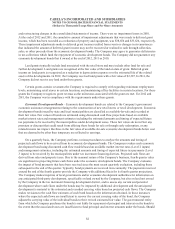Cabela's 2012 Annual Report Download - page 90
Download and view the complete annual report
Please find page 90 of the 2012 Cabela's annual report below. You can navigate through the pages in the report by either clicking on the pages listed below, or by using the keyword search tool below to find specific information within the annual report.80
CABELA’S INCORPORATED AND SUBSIDIARIES
NOTES TO CONSOLIDATED FINANCIAL STATEMENTS
(Dollars in Thousands Except Share and Per Share Amounts)
conditions affecting key lending areas, credit concentration, changes in origination and portfolio management,
and credit quality trends. Since the evaluation of the inherent loss with respect to these factors is subject to a high
degree of uncertainty, the measurement of the overall allowance is subject to estimation risk, and the amount of
actual losses can vary significantly from the estimated amounts.
Credit card loans that have been modified through a fixed payment plan or placed on non-accrual are
considered impaired and are collectively evaluated for impairment. The Financial Services segment charges off
credit card loans and restructured credit card loans on a daily basis after an account becomes at a minimum 130
days contractually delinquent. Accounts relating to cardholder bankruptcies, cardholder deaths, and fraudulent
transactions are charged off earlier. The Financial Services segment recognizes charged-off cardholder fees and
accrued interest receivable in interest and fee income that is included in Financial Services revenue.
Inventories – Inventories are stated at the lower of average cost or market. All inventories are finished goods.
The reserve for inventory shrinkage, estimated based on cycle counts and physical inventories, was $6,029 and
$5,412 at the end of 2012 and 2011, respectively. The reserves for returns of damaged goods, obsolescence, and
slow-moving items, estimated based upon historical experience, inventory aging, and specific identification, were
$5,602 and $6,735 at the end of 2012 and 2011, respectively.
Vendor Allowances – Vendor allowances include price allowances, volume rebates, store opening costs
reimbursements, marketing participation, and advertising reimbursements received from vendors under vendor
contracts. Vendor merchandise allowances are recognized as a reduction of the costs of merchandise as sold.
Vendor reimbursements of costs are recorded as a reduction to expense in the period the related cost is incurred
based on actual costs incurred. Any cost reimbursements exceeding expenses incurred are recognized as a
reduction of the cost of merchandise sold. Volume allowances may be estimated based on historical purchases and
estimates of projected purchases.
Deferred Catalog Costs and Advertising – Advertising production costs are expensed as the advertising
occurs except for catalog costs which are amortized over the expected period of benefit estimated at three to
12 months after mailing. Unamortized catalog costs totaled $7,713 and $13,235 at the end of 2012 and 2011,
respectively. Advertising expense, including direct marketing costs (amortization of catalog costs and website
marketing paid search fees), was $201,456, $186,142, and $179,008 for 2012, 2011, and 2010, respectively.
Advertising vendor reimbursements netted in advertising expense above totaled $3,049, $919, and $1,501 for 2012,
2011, and 2010, respectively.
Store Pre-opening Expenses – Non-capital costs associated with the opening of new stores are expensed
as incurred.
Leases – The Company leases certain retail locations, distribution centers, office space, equipment and land.
Assets held under capital lease are included in property and equipment. Operating lease rentals are expensed on
a straight-line basis over the life of the lease. At the inception of a lease, the Company determines the lease term
by assuming the exercise of those renewal options that are reasonably assured because of the significant economic
penalty that exists for not exercising those options. The exercise of lease renewal options is at the Company’s sole
discretion. The expected lease term is used to determine whether a lease is capital or operating and is used to
calculate straight-line rent expense. Additionally, the depreciable life of buildings and leasehold improvements is
limited by the expected lease term.
Property and Equipment – Property and equipment are stated at cost. Depreciation and amortization are
provided over the estimated useful lives of the assets, including assets held under capital leases, on a straight-
line basis. Leasehold improvements are amortized over the lease term or, if shorter, the useful lives of the
improvements. Assets held under capital lease agreements are amortized using the straight-line method over the
























